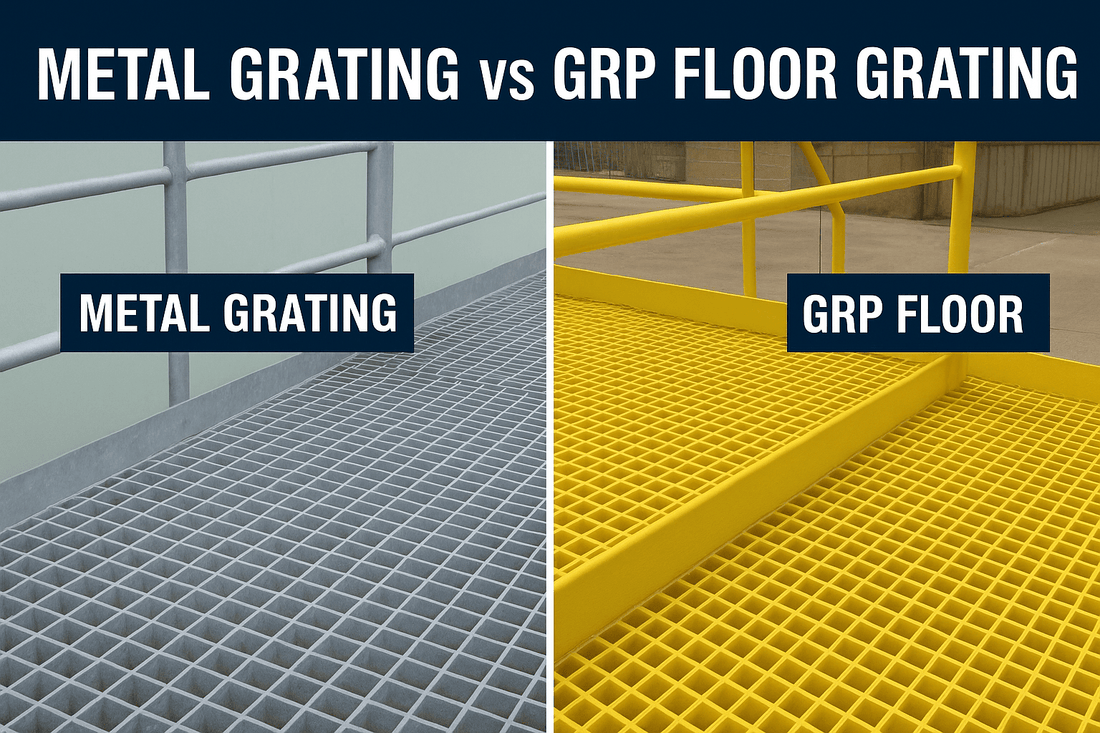When it comes to safe, durable, and cost-effective flooring solutions, both metal grating and GRP (Glass Reinforced Plastic) floor grating are widely used in industrial, marine, and commercial environments. But which one should you choose for your project? Let’s break down the key differences so you can make an informed decision.
What Is Metal Grating?
Metal grating is a flooring system made from steel, stainless steel, or aluminium, featuring open mesh-style panels designed to allow water, air, and light to pass through.
It’s commonly used in:
-
Industrial walkways
-
Mezzanine floors
-
Stair treads and access platforms
✅ Advantages of Metal Grating:
-
High load-bearing strength: Ideal for heavy machinery areas.
-
Heat and fire resistance: Performs well in high-temperature environments.
-
Recyclable material: Steel is sustainable and can be reused.
⚠️ Limitations of Metal Grating:
-
Corrosion: Rusts easily when exposed to moisture or chemicals.
-
Heavy weight: Increases transport and installation costs.
-
High maintenance: Requires galvanising or repainting to prevent rust.
-
Slippery surface: Can be hazardous in wet or oily conditions.
What Is GRP Floor Grating?
GRP (Glass Reinforced Plastic) grating, also known as FRP grating, is made from a combination of resin and glass fibres.
It’s lightweight, non-corrosive, and designed to deliver long-term durability in even the harshest environments.
✅ Advantages of GRP Floor Grating:
-
Corrosion and rust-proof: Perfect for marine, chemical, and outdoor use.
-
Non-slip surface: Offers superior grip even in oily or wet conditions.
-
Lightweight yet strong: Up to 70% lighter than steel but just as durable.
-
Zero maintenance: No need for painting or coating.
-
Non-conductive: Safe for electrical or chemical areas.
-
Easy installation: Can be cut and fitted without heavy machinery.
⚠️ Limitations of GRP Grating:
-
Higher initial cost compared to mild steel.
-
Not suitable for extremely high-temperature environments.
Metal vs GRP Grating — Head-to-Head Comparison
| Feature | Metal Grating | GRP Floor Grating |
|---|---|---|
| Weight | Heavy | Lightweight |
| Corrosion Resistance | Poor (needs coating) | Excellent |
| Slip Resistance | Moderate | High |
| Maintenance | High | Low |
| Installation | Labour-intensive | Simple |
| Cost (Long-term) | Higher | Lower |
| Conductivity | Conductive | Non-conductive |
| Aesthetics | Industrial look | Modern & versatile |
Best Applications for Each
Metal Grating is best for:
-
Heavy-load industrial floors
-
Factories with high temperatures
-
Environments with low corrosion risk
GRP Floor Grating is best for:
-
Marine & offshore platforms
-
Chemical plants and wastewater sites
-
Public walkways, ramps, and pedestrian bridges
-
Any outdoor or corrosive environment
Why UK Businesses Are Shifting to GRP Grating
In the UK, industries are increasingly adopting GRP floor grating due to its durability, safety, and compliance with HSE (Health and Safety Executive) standards.
It’s also a more eco-friendly and long-lasting investment, reducing the need for constant maintenance or replacements.
Final Verdict: GRP Grating Wins for Long-Term Value
While metal grating still has its place in heavy industrial applications, GRP floor grating offers a clear advantage in terms of longevity, safety, and total cost of ownership.
If you’re looking for a corrosion-proof, low-maintenance, and non-slip solution, GRP grating is the smarter choice for modern UK businesses.

